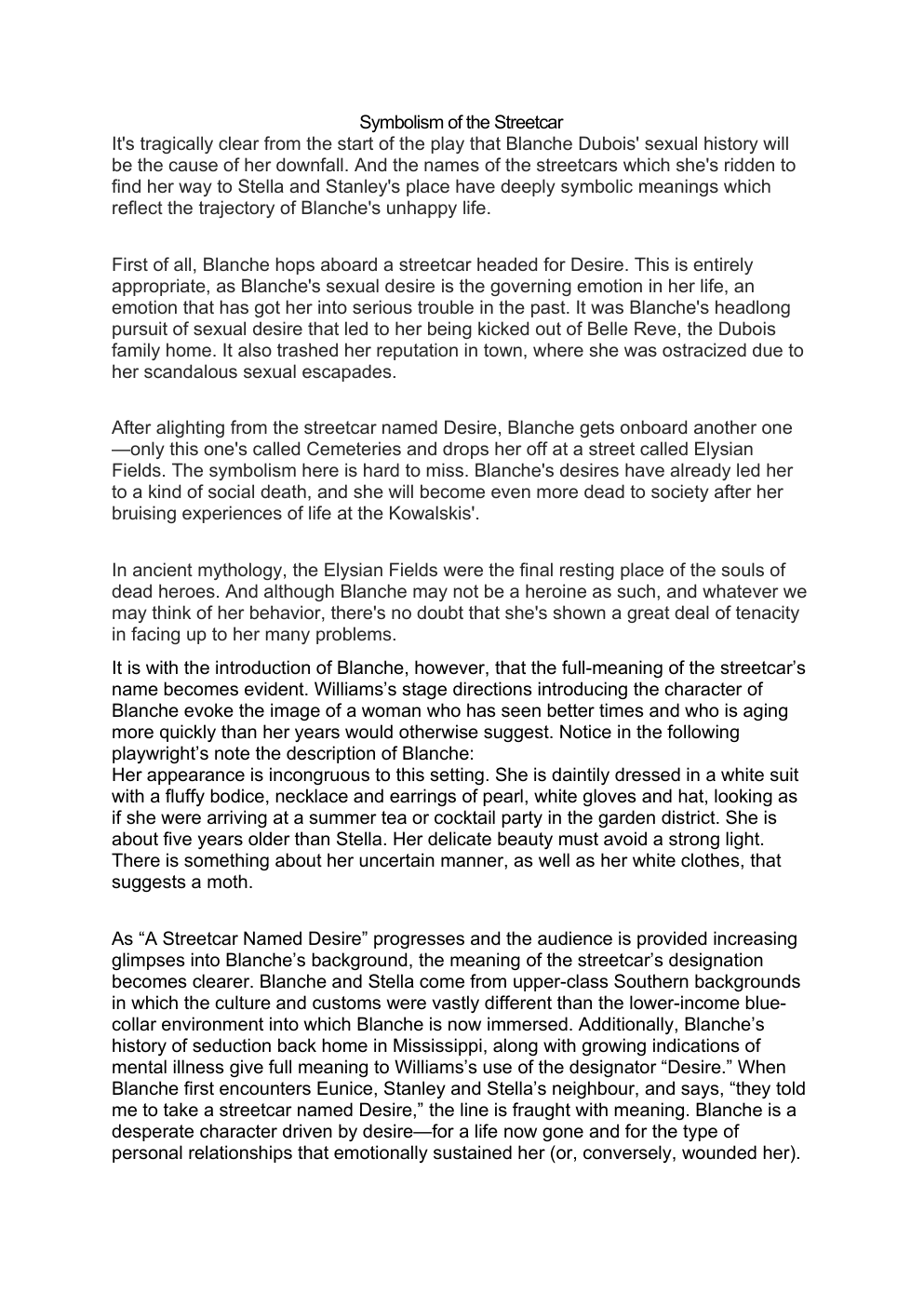Sybolism of the Streetcar in a streetcar named desire
Publié le 05/09/2022

Extrait du document
«
Symbolism of the Streetcar
It's tragically clear from the start of the play that Blanche Dubois' sexual history will
be the cause of her downfall.
And the names of the streetcars which she's ridden to
find her way to Stella and Stanley's place have deeply symbolic meanings which
reflect the trajectory of Blanche's unhappy life.
First of all, Blanche hops aboard a streetcar headed for Desire.
This is entirely
appropriate, as Blanche's sexual desire is the governing emotion in her life, an
emotion that has got her into serious trouble in the past.
It was Blanche's headlong
pursuit of sexual desire that led to her being kicked out of Belle Reve, the Dubois
family home.
It also trashed her reputation in town, where she was ostracized due to
her scandalous sexual escapades.
After alighting from the streetcar named Desire, Blanche gets onboard another one
—only this one's called Cemeteries and drops her off at a street called Elysian
Fields.
The symbolism here is hard to miss.
Blanche's desires have already led her
to a kind of social death, and she will become even more dead to society after her
bruising experiences of life at the Kowalskis'.
In ancient mythology, the Elysian Fields were the final resting place of the souls of
dead heroes.
And although Blanche may not be a heroine as such, and whatever we
may think of her behavior, there's no doubt that she's shown a great deal of tenacity
in facing up to her many problems.
It is with the introduction of Blanche, however, that the full-meaning of the streetcar’s
name becomes evident.
Williams’s stage directions introducing the character of
Blanche evoke the image of a woman who has seen better times and who is aging
more quickly than her years would otherwise suggest.
Notice in the following
playwright’s note the description of Blanche:
Her appearance is incongruous to this setting.
She is daintily dressed in a white suit
with a fluffy bodice, necklace and earrings of pearl, white gloves and hat, looking as
if she were arriving at a summer tea or cocktail party in the garden district.
She is
about five years older than Stella.
Her delicate beauty must avoid a strong light.
There is something about her uncertain manner, as well as her white clothes, that
suggests a moth.
As “A Streetcar Named Desire” progresses and the audience is provided increasing
glimpses into Blanche’s background, the meaning of the streetcar’s designation
becomes clearer.
Blanche and Stella come from upper-class Southern backgrounds
in which the culture and....
»
↓↓↓ APERÇU DU DOCUMENT ↓↓↓
Liens utiles
- Eating the Other: Desire and Resistence
- Styx, River Greek The principle river, or system of rivers, in Hades, the Greek Underworld (1); named for the goddess who carried the same name, Styx.
- Virgo (Virgin) Greek One of the constellations; sixth sign of the Zodiac, named for the maiden Erigone, who hanged herself from a tree after finding the grave of her murdered father, Icarius of Attica.
- Animation I INTRODUCTION Finding Nemo A clown fish named Marlin, left, and his friend Dory search for Marlin's son in the computer-animated feature film Finding Nemo (2003).
- The Teachings of Muhammad During the early 7th century, a trader named Muhammad was meditating in a cave near Mecca in what is now Saudi Arabia, when he experienced a vision of the archangel Gabriel who declared Muhammad to be a prophet of God.

































